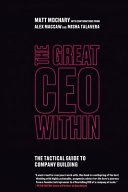
From "The Great CEO Within: The Tactical Guide to Company Building"
Implementing a Structured Meeting Cadence and Best Practices
Key Economic Insight
An effective meeting cadence is critical for a scaling company, aiming to balance collaborative time with uninterrupted focus for 'makers' like engineers. The recommended five-day workweek schedule allocates one day for internal meetings, one for external meetings (e.g., candidate interviews), and three days for focused, uninterrupted work. While recruiters might challenge the single-day interview schedule, arguing it could limit candidate availability, the benefits of increased company productivity from dedicated focus days significantly outweigh the risk of losing a few candidates, especially if the in-person interview hire rate is around 75 percent, implying effective prior screening.
The internal meeting day should follow a structured order: starting with weekly one-on-one meetings, followed by the leadership team meeting, a CEO open office hour, an all-hands meeting, and concluding with a company-wide social event. As the company grows, department and subteam meetings should be scheduled on separate days preceding the CEO's meeting day, ensuring updates and issues are prepared in advance. Every meeting requires a designated meeting lead responsible for publishing the agenda, desired outcomes, and attendee list; ensuring participants submit updates in writing beforehand and arrive on time; and rigorously adhering to the schedule, deferring off-topic discussions.
Weekly one-on-one meetings prepare individuals for team meetings, focusing on accountability (tracking actions and OKRs), coaching (identifying issues, proposing solutions, asking for manager help), and transparency (giving and receiving 'Like' and 'Wish that' feedback). Managers should elicit negative feedback, appreciate it, and act on it. The leadership team meeting discusses issues from one-on-ones, aiming to resolve them or assign them to a 'RAPID' decision-making process, also following the ACT model with a strong emphasis on written submissions to ensure efficiency. A CEO open office hour allows any employee to raise issues, and an all-hands meeting shares leadership team decisions and allows for broader company feedback. For larger companies, a VPs meeting informs department leads of leadership decisions, offering a final chance to flag unintended negative consequences before company-wide publication.
📚 Continue Your Economic Learning Journey
Access the complete The Great CEO Within: The Tactical Guide to Company Building summary with audio narration, key takeaways, and actionable insights from Matt Mochary.